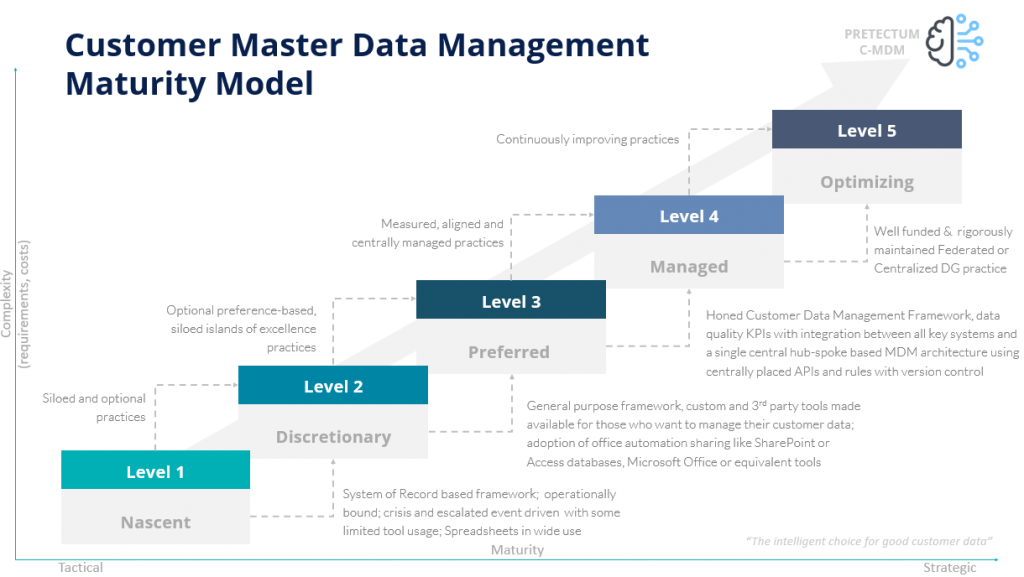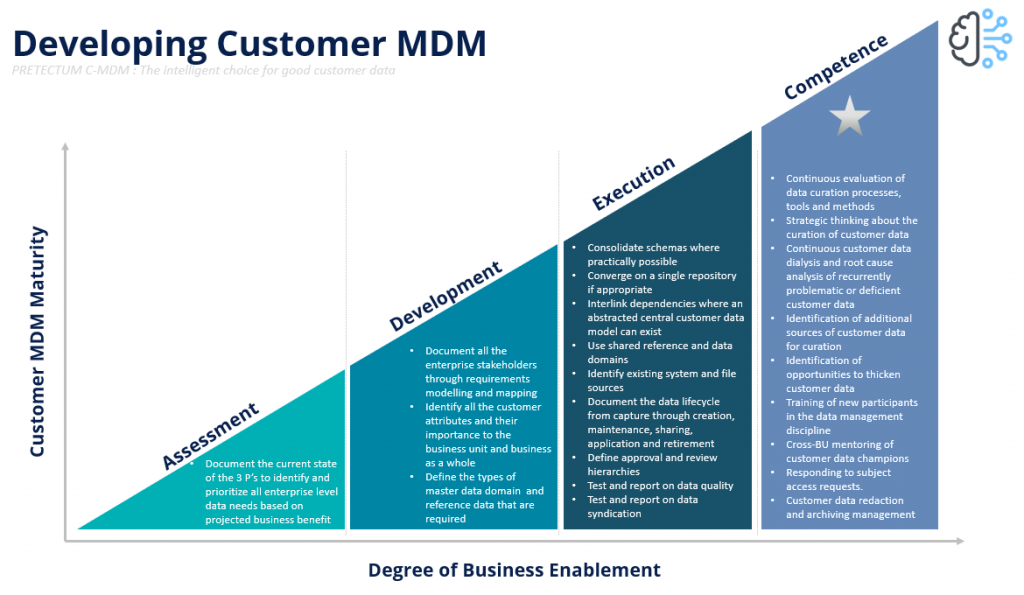When businesses start out, they simply collect data. Initially, perhaps, there simply isn’t enough data collected to be particularly concerned about what is gathered and where it is stored or the processes and procedures associated with managing it.
With the passage of time, that small seed of data grows, it becomes more complex and various forces are brought to bear on your organization to implement better controls, examine the data regularly, organize it, clean it and ensure that the data is the best that it can be, and above all, that it is secure.
That’s the theory at least.
Most organizations acknowledge the importance of their customer master data and its management of it. Those that have a coherent plan are the ones that are most likely to grow and flourish. Organizations that take customer data management seriously, are the ones that provide customers with a better overall experience and have the ability to customize and personalize the way that they interact with their customers. Their messaging, communication, and interaction are clearer, targeted, and appropriate and there is minimal repetition and friction in the customer-employee engagement model is able to be reduced because associates have the best information about the customer close at hand.
How do these organizations do it? They’re doing it with that customer master data that may have started out small, fragmented and incomplete, but they’ve elevated its value of it to an organizational data asset.
Conversely, those organizations that don’t have effective data management practices, often are witness to faltering marketing and sales initiatives with surprisingly poor investment returns. Though many organizations look to data management as a way to improve organizational efficiency and effectiveness. some continue to labor under the illusion that data can take care of itself. Of course, it can’t.
Data management as a practice, of which data quality management and master data management are sub-elements, is also able to reduce overall costs for an organization. These costs relate to wasted time searching for the right data assets, wasted time sifting through duplicates, and dealing with the vagaries of poor data quality. For the organizations that resist the adoption of mainstream data management practices, they can only imagine the streams of savings that could be associated with improved data quality and the benefits this has to sales, service, support, and marketing.
Harvard Business Review stated that bad data costs companies $3.1 trillion per year with the average business losing as much as $9.7 million due to bad data alone. To close the gap between cost and benefit, organizations must embrace data management and consider how they evolve their data management and data governance practice.
A standard data management optimization approach features four levels of evolution. Data Management Optimization itself is a process of upgrading your data practices and simultaneously modernizing the infrastructure that supports the practice to improve the overall performance of the practice and reduce operating costs.

Chaotic
Many companies endure the chaos phase, some of them seemingly quite successful. Since the practice itself is evolutionary, until such time as you begin to take action to improve your practice and move to more sophisticated management practice, chaos and ad hoc practices will prevail. The neglect of the practice is often tied to fast organic growth and overall business success and there is a lot of patience with dealing with fractured customer data and duplicates because perhaps the numbers are small and the impact is felt to be relatively insignificant.
Companies in this phase are actively collecting all kinds of customer data and depending on who the customer is interacting with, and the sophistication of systems in use, this could range from basic data like names and contact details right through to transactions and interactions. Teams may skip over data fields or not know where to put data that they have acquired. It’s this set of problems that often leads to the growth of data silos, everything is ad hoc, with best efforts with potential missteps along the way. No one owns the data yet everyone feels somewhat responsible.
Visible
In this stage, the business recognizes a data problem and starts to take steps to get an understanding of the exact status of things like the customer master. Efforts will be applied to looking for all the places where customer data resides and trying to determine the overall quality of the customer data. You’ll be looking for missing data, incorrectly captured data, and potential duplicates. Part of this process might also be the establishment of some basic data rules and some manual processes around the creation, editing, and management of the data as a whole.
Often we will see a particular system being selected as having the final say on what the customer record looks like. This doesn’t eliminate the mini-apps, databases, and spreadsheets that may have proliferated but it does start the business on a journey where there is some notion of an idea of what a good customer record looks like and how to elevate the quality of all the customer records held.
Standardized
As mentioned, earlier, in the “making things visible” stage, there may be some attempt to nominate a particular system as having the ultimate say in what a good customer record looks like or in fact trying to function as a data master.
What also happens is that sometimes efforts are put in place to set some data standards. There may be the addition of some address validation, some mandatory record-keeping expectations, or even some rules established around how short or long strings should be. Often these business rules are encapsulated in a data quality standards document. But unless they are also baked into the systems that capture and hold that customer data, they will rapidly deteriorate in value and almost certainly will be not reasonably enforceable.
In the standardization phase, we’re all about defining the data rules. We do this to avoid ambiguity, the kind of crippling stuff that happens when data repositories and data management practices are growing in an uncontrolled and organic way.
The standardization approach helps operational teams to better understand what is expected from them, the impacts of certain kinds of data across functions, and specifically, which fields are required by marketing, accounting, sales, service, and support. Everyone who needs to enter data now knows what needs to be captured, what needs to be fixed, and how the data needs to look to be good enough for the job.
It’s at this stage that we believe the Pretectum CMDM platform really starts to demonstrate its strength to your business and business data management practice.

Optimizing
If you are at this stage then it sounds like you already have a good understanding of the data that you have, who is using it, and how. Any customer master data management approach should align with the organization’s IT strategy, at least in terms of how data is captured, quality assessed, and maintained, and how the customer data is stored, used, and kept private and secure. Pretectum’s CMDM platform provides your business with rigor and flexibility all encapsulated in a single SaaS platform replete with a rich UI and APIs and the ability to support small, medium, and large-scale needs.
All the established standards you may have, sometimes make optimization difficult. Oftentimes this is because the approach to the management of customer data has been prescribed by a particular vendor’s platform or because the business simply allowed IT to be the bailiff, judge, and jury in all matters pertaining to the management of the customer master. Pretectum thinks this approach is downright wrong because ultimately if the data is not fit for purpose, it is the business users that have to deal with the fallout that relates to missing, duplicated, or incomplete customer records. However, IT can help the business with the evaluation and consideration of all the possible tools, approaches, and methods that could be considered for optimization of the customer master data management discipline.
There are many reasons that you might want IT involved in the process. They’ll look at the security of the applications, they will look at the architecture and opportunities for connectivity and they’ll look to find ways to avoid adding yet another application or platform to the landscape that ultimately will bring some degree of work to their table.
We believe that the Pretectum CMDM platform is already highly optimized for the best practices of Customer Master Data Management, all you need to do is define your business rules and schemas and start managing your customer data. We support all the major approaches to Customer MDM
Learn how the Pretectum CMDM can help you as a single domain MDM software solution designed specifically to address the challenges of Customer Master Data Management.


